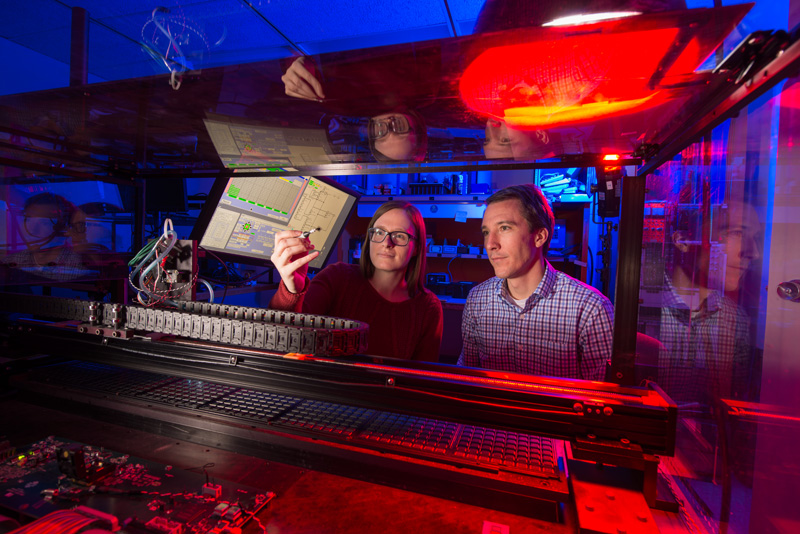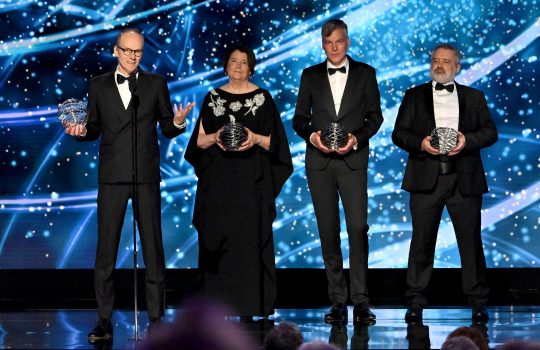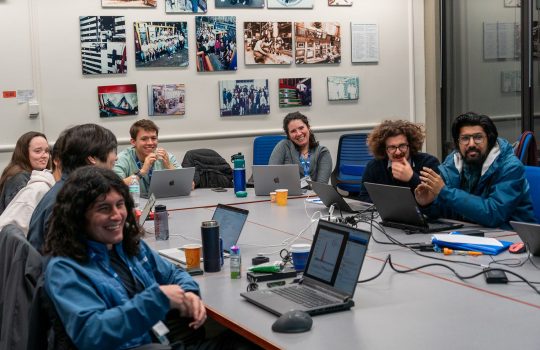The CMS experiment at CERN’s Large Hadron Collider has achieved yet another significant milestone in its already storied history as a leader in the field of high-energy experimental particle physics. The U.S. contingent of the CMS collaboration, known as USCMS and managed by Fermilab, has been granted the Department of Energy’s final Critical Decision- 4 approval for its multiyear Phase 1 Detector Upgrade program, formally signifying the completion of the project after having met every stated goal — on time and under budget.
“Getting CD-4 approval is a tremendous vote of confidence for the many people involved in CMS,” said Fermilab scientist Steve Nahn, U.S. project manager for the CMS detector upgrade. “The LHC is the best tool we have for further explication of the particle nature of the universe, and there are still mysteries to solve, so we have to have the best apparatus we can to continue the exploration.”
The CMS experiment is a generation-spanning effort to build, operate and upgrade a particle-detecting behemoth that observes its protean prey in a large but cramped cavern 300 feet beneath the French countryside. CMS is one of four large experiments situated along the LHC accelerator complex, operated by CERN in Geneva, Switzerland. The LHC is a 17-mile-round ring of magnets that accelerates two beams of protons in opposite directions, each to 99.999999999% the speed of light, and forces them to collide at the centers of CMS and the LHC’s other experiments: ALICE, LHCb and ATLAS.

Fermilab scientists Nadja Strobbe and Jim Hirschauer test chips for the CMS detector upgrades. Photo: Reidar Hahn
The main goal of CMS (and the other LHC experiments) is to keep track of which particles emerge from the rapture of pure energy created from the collisions in order to search for new particles and phenomena. In catching sight of such new phenomena, scientists aim to answer some of the most fundamental questions we have about how the universe works.
The global CMS collaboration comprises more than 5,000 professionals — including roughly 1,000 students — from over 200 institutes and universities across more than 50 countries. This international team collaborates to design, build, commission and operate the CMS detector, whose data is then distributed to dedicated centers in 40 nations for analysis. And analysis is their raison d’etre. By sussing out patterns in the data, CMS scientists search for previously unseen or unconfirmed phenomena and measure the properties of elementary particles that make up the universe with greater precision. To date, CMS has published over 900 papers.
The USCMS collaboration is the single largest national group in CMS, involving 51 American universities and institutions in 24 states and Puerto Rico, over 400 Ph.D. physicists, and more than 200 graduate students and other professionals. USCMS has played a primary role in much of the CMS experiment’s original design and construction, including a wide network of eight CMS computing centers located across the United States, and in the experiment’s data analysis. USCMS is supported by the U.S. Department of Energy and the National Science Foundation and has played an integral role in the success of the CMS collaboration as a whole from its founding.
The CMS experiment, the LHC and the other LHC experiments became operational in 2009 (17 years after the CMS letter of intent), beginning a 10-year data-taking period referred to as Phase 1.
Phase 1 was divided into four major epochs, alternating two periods of data-taking with two periods of maintenance and upgrade operations. The two data-taking periods are referred to as Run 1 (2009-2013) and Run 2 (2015-2018). It was during Run 1 (in 2012) that the CMS and ATLAS collaborations jointly announced they each had observed the long predicted Higgs boson, resulting in a Nobel Prize awarded a year later to scientists Peter Higgs and François Englert, and a further testament to the strength of the Standard Model of particle physics, the theory within which the Higgs boson was first hypothesized in 1964.
“That prize was a historic triumph of every individual, institution and nation involved with the LHC project, not only validating the Higgs conjecture, a cornerstone of the Standard Model, but also giving science a new particle to use as a tool for further exploration,” Nahn said. “This discovery and every milestone CMS has achieved since then is encouragement to continue working toward further discovery. That goes for our latest approval milestone.”

Fermilab scientist Maral Alyari and Stephanie Timpone conduct CMS pixel detector work. Photo: Reidar Hahn
During the entirety of Phase 1, the wizard-like LHC particle accelerator experts were continually ramping up the collision energy and intensity, or in particle physics parlance, the luminosity of the LHC beam. The CMS technical team was charged with fulfilling the Phase 1 Upgrade plan, a series of hardware upgrades to the detector that allowed it to fully profit from the gains the LHC team was providing.
While the LHC accelerator folks were prepping to push 20 times as many particles through the experiments per second, the experiments were busy upgrading their systems to handle this major influx of particles and the resulting data. This meant updating many of the readout electronics with faster and more capable brains to manage and process the data produced by CMS.
With support from the Department of Energy’s Office of Science and the National Science Foundation, USCMS implemented $40 million worth of these strategic upgrades on time and under budget.
With these upgrades complete, the CMS detector is now ready for LHC Run 3, which will go from 2021-23, and the collaboration is starting the stage of data taking on a solid foundation.
Still, USCMS isn’t taking a break: The collaboration is already gearing up for its next, even more ambitious set of upgrades, planned for installation after Run 3. This USCMS upgrade phase will prepare the detector for an even higher luminosity, resulting in a data set 10 times greater than what the LHC provides currently.
Every advance in the CMS detector ensures that it will support the experiment through 2038, when the LHC is planned to complete its final run.
“For the last decade, we’ve worked to improve and enhance the CMS detector to squeeze everything we can out of the LHC’s collisions,” Nahn said. “We’re prepared to do the same for the next two decades to come.”



